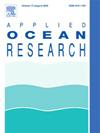Research on sloshing characteristics for liquefied iron ore and size optimization of anti-sloshing baffle based on data-driven models
IF 4.3
2区 工程技术
Q1 ENGINEERING, OCEAN
引用次数: 0
Abstract
The impact of liquefied cargo sloshing on the safety of ship navigation has increased significantly in recent years. Implementing anti-sloshing baffles is an effective measure to mitigate the risk. However, the sloshing characteristics of liquefied iron ore should be addressed firstly. This paper employs a model experiment methodology using Carbomer 940 solution to simulate liquefied iron ore, given its similar rheological properties. The study examines the effects of filling level, excitation frequency and amplitude on the sloshing behavior. The sloshing characteristics were summarized. To determine the optimal size of the anti-sloshing baffle, a data-driven approach is utilized. Featuring motion period, baffle length, and baffle width as input variables, with impact pressure and center of gravity displacement as output variables, different prediction modes were established. The BPNN model demonstrates excellent generalization performance and identifies an optimal baffle size of 201.6 mm in length and 480 mm in width. This configuration reduces cargo gravity center displacement by 23.3 % compared to scenarios without baffles. This research not only fills a critical gap in the design of anti-sloshing devices for iron ore cargo ships but also provides a robust methodology for optimizing baffle sizes using advanced data-driven techniques.
基于数据驱动模型的液化铁矿石晃动特性及防晃动挡板尺寸优化研究
近年来,液化货物晃动对船舶航行安全的影响越来越大。设置防晃动挡板是降低风险的有效措施。但首先要解决的是液化铁矿石的晃动特性。考虑到铁矿石具有相似的流变特性,本文采用卡波默940溶液模拟液化铁矿石的模型实验方法。研究了填充水平、激励频率和振幅对晃动特性的影响。总结了晃动特性。为了确定抗晃动挡板的最佳尺寸,采用了数据驱动的方法。以运动周期、挡板长度和挡板宽度为输入变量,以冲击压力和重心位移为输出变量,建立了不同的预测模型。BPNN模型显示了良好的泛化性能,并确定了长度为201.6 mm,宽度为480 mm的最佳挡板尺寸。与没有挡板的情况相比,这种配置减少了货物重心位移23.3%。这项研究不仅填补了铁矿石货船防晃动装置设计的关键空白,而且为利用先进的数据驱动技术优化挡板尺寸提供了一种可靠的方法。
本文章由计算机程序翻译,如有差异,请以英文原文为准。
求助全文
约1分钟内获得全文
求助全文
来源期刊

Applied Ocean Research
地学-工程:大洋
CiteScore
8.70
自引率
7.00%
发文量
316
审稿时长
59 days
期刊介绍:
The aim of Applied Ocean Research is to encourage the submission of papers that advance the state of knowledge in a range of topics relevant to ocean engineering.
 求助内容:
求助内容: 应助结果提醒方式:
应助结果提醒方式:


